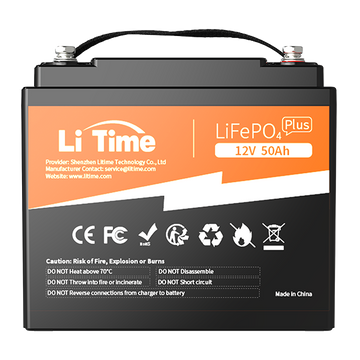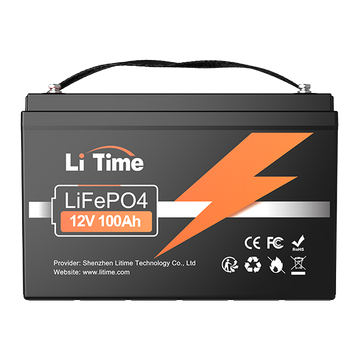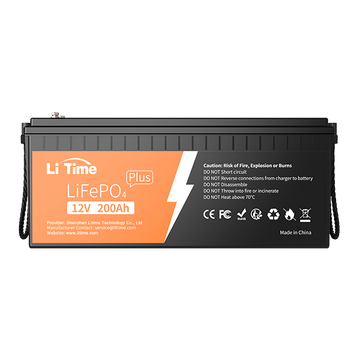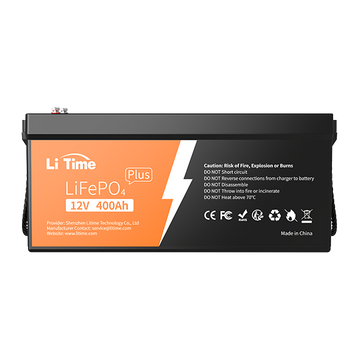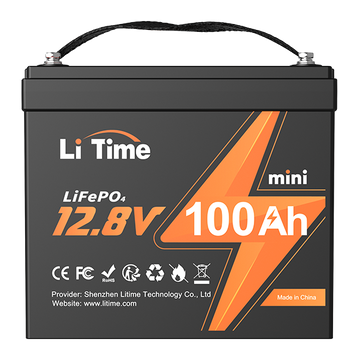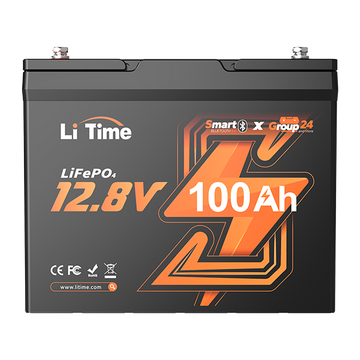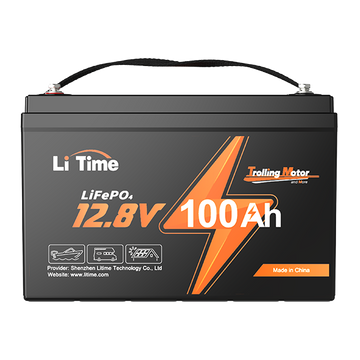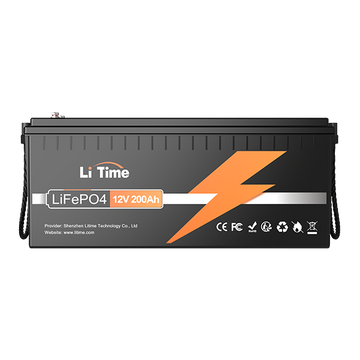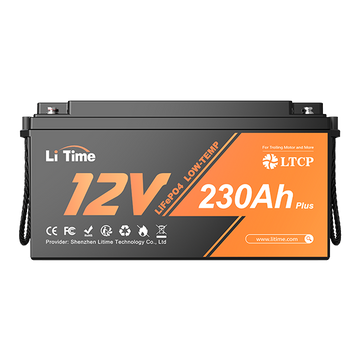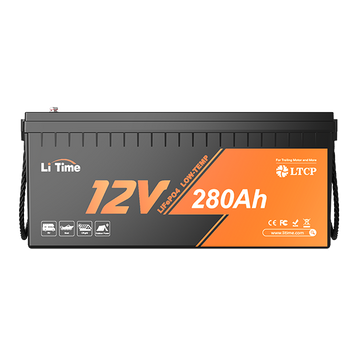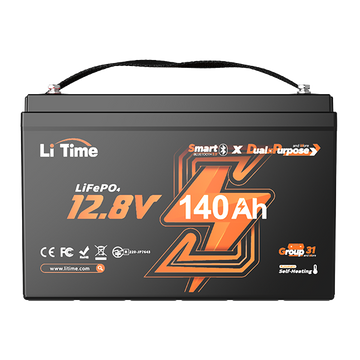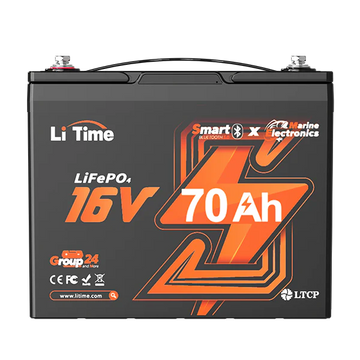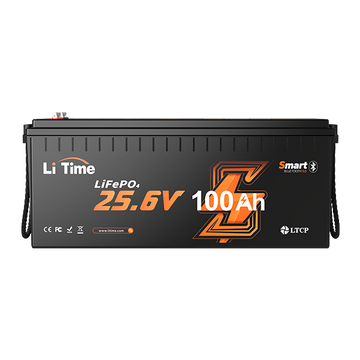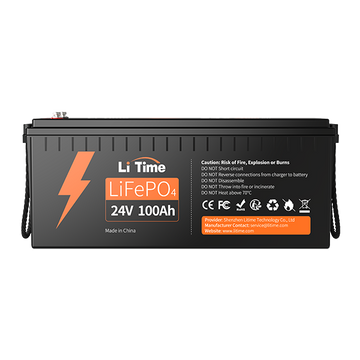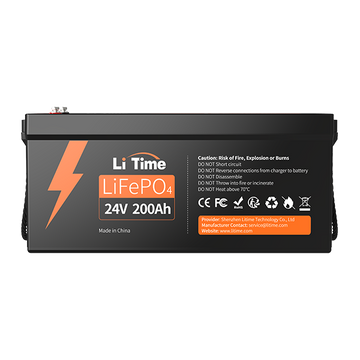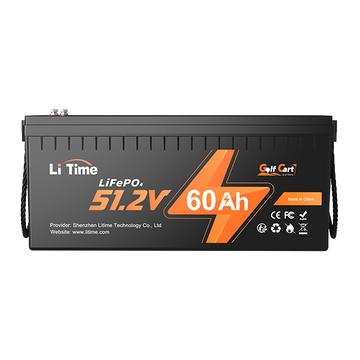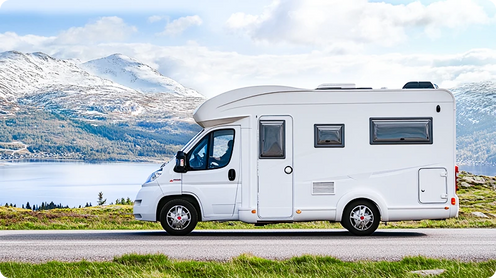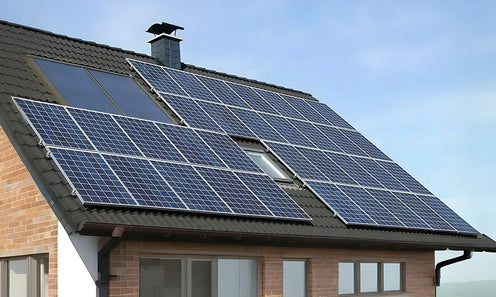There's no one-size-fits-all answer to how long a 200Ah battery will last. Its runtime is influenced by various factors, including battery capacity, voltage, depth of discharge (DoD), inverter efficiency, and the energy demand of connected devices.
To simplify this for you, we've developed a handy runtime calculator that lets you estimate your battery's operating time with ease.
Battery Runtime Calculator
Runtime: -- hours
Let's break it down with an example: Imagine you're using a 12.8V 200Ah lithium iron phosphate (LiFePO4) battery. With a full 100% depth of discharge and an inverter operating at 90% efficiency, it can power a 600W microwave for approximately 3.84 hours.
Of course, this calculation is just a starting point. To get a more accurate understanding of your battery's performance, it's important to dive into the factors that affect its runtime.
In the following section, we'll explore these key variables and how they impact your battery in real-world applications.
Table of Content
- 5 Key Factors That Impact Battery Runtime
- 1. Battery Voltage
- 2. Battery Capacity
- 3. Depth of Discharge (DOD)
- 4. Inverter Efficiency
- 5. Energy Consumption
- 6. Other Factors That Affect Battery Performance:
- How to Calculate the Runtime of a 200Ah Battery
- Real-Life Example: Helping You Understand Battery Runtime
- How to Maximize the Runtime of Your 200Ah Battery: Practical Tips
- 1. Optimize Power Usage
- 2. Boost Inverter Efficiency
- 3. Manage Depth of Discharge
- 4. Maintain the Right Temperature
- 5. Perform Regular Battery Maintenance
- 6. Charge with Solar or Other Devices
- FAQ: Everything You Need to Know About the 200Ah Battery
5 Key Factors That Impact Battery Runtime
Battery runtime is influenced by several critical factors. While there are many elements that play a role in determining how long a battery lasts, we'll focus on the top five key factors in this article, and also delve into other aspects that will help you fully understand battery performance.
1. Battery Voltage
Voltage is a crucial factor that impacts a battery's energy output. It's the potential difference between the two battery terminals.
In simple terms, the higher the voltage, the more energy the battery can deliver at the same capacity. This is because the total energy (Wh) = Voltage (V) × Capacity (Ah).
2. Battery Capacity
Battery capacity indicates how much energy the battery can store, and it's typically measured in ampere-hours (Ah). It tells you how much current the battery can supply within an hour. For example:
A 200Ah battery means:
- At 200 amperes, the battery supports the load for 1 hour.
- At 20 amperes, the battery supports the load for 10 hours.
The larger the capacity, the more energy the battery can store. With the same power demands, a battery with a higher capacity will extend the runtime of your devices. For instance, a 200Ah battery provides double the runtime of a 100Ah battery.
In short, battery capacity directly impacts how long a battery can power your devices, making it one of the most important factors in determining its overall energy reserve.
3. Depth of Discharge (DOD)
The Depth of Discharge (DOD) refers to the percentage of the battery's energy that has been discharged relative to its total capacity.
The greater the DOD, the more usable energy the battery can provide, and the longer it will last. For example:
For a 200Ah battery, if the DOD is 50%, only 200Ah × 50% = 100Ah is available for use. At 100% DOD, the entire 200Ah capacity can be used.
Lead-acid batteries typically have a recommended DOD of 50% because discharging beyond that can damage the internal chemical structure, significantly reducing the battery's lifespan.
For instance, if a 200Ah lead-acid battery is only discharged to 50%, the usable capacity drops to 100Ah.
On the other hand, Lithium Iron Phosphate (LiFePO4) batteries can safely handle a 100% DOD, meaning you can use all of the battery's energy without causing significant wear and tear.
In the case of a 200Ah LiFePO4 battery, a 100% DOD means you can safely use the full 200Ah capacity.
When choosing between battery types, consider your budget and needs: for more efficient energy usage, LiFePO4 batteries are ideal, while lead-acid batteries offer an attractive, budget-friendly option.
4. Inverter Efficiency
Inverter efficiency is typically expressed as a percentage, indicating the proportion of DC power from the battery that is converted to AC power, which is required by most appliances.
Since energy losses are inevitable during the conversion process, no inverter can achieve 100% efficiency.
The higher the efficiency, the less energy is wasted, which directly affects the available energy from the battery and how long your devices can run.
Here’s an example:
- 90% Efficiency: The inverter converts 90% of the battery’s energy into usable power, with only 10% wasted.
- 80% Efficiency: More energy is lost in the conversion, which shortens the runtime of your equipment.
Opting for a high-efficiency inverter not only extends your battery's usage but also reduces additional energy costs caused by losses, making it a smart strategy for improving overall energy efficiency.
5. Energy Consumption
Energy consumption refers to the amount of power a device needs to operate, typically measured in watts (W).
Devices are the main consumers of battery energy—meaning the battery itself doesn't consume power; the rate of discharge depends on the device's operation.
To maximize battery efficiency, it's essential to accurately assess the energy consumption of all devices using the battery and optimize the setup based on your specific usage.
6. Other Factors That Affect Battery Performance:
- Ambient Temperature: Cold temperatures can slow down the battery's chemical reactions, reducing its discharge ability and shortening runtime. On the flip side, excessive heat can accelerate the aging process inside the battery, shortening its lifespan.
- Battery Health and Lifespan: As the battery ages over time, its capacity naturally decreases, leading to reduced performance.
By understanding and managing these factors, you can optimize your battery's performance and ensure it lasts as long as possible.
How to Calculate the Runtime of a 200Ah Battery
To figure out how long a 200Ah battery will last, you can use this simple formula:
Battery Runtime = (Battery Capacity × Battery Voltage × Depth of Discharge × Inverter Efficiency) / Energy Consumption
This formula takes into account five crucial factors: battery capacity, voltage, depth of discharge, inverter efficiency, and the energy consumption of the device, providing a quick way to calculate the runtime under ideal conditions.
While other factors like battery health and temperature do play a role in the long-term performance, they are not included in this calculation since they are harder to measure and don’t have an immediate effect on runtime.
Let's take a look at a practical example to show how you can apply this formula and get a clear understanding of how to calculate battery runtime.
Real-Life Example: Helping You Understand Battery Runtime
To make it easier to understand how battery runtime is calculated, we've provided a real-world example using the LiTime Lithium Iron Phosphate (LiFePO4) battery. This example, based on the specific parameters of the LiTime battery and everyday scenarios, shows you how to apply the formula to calculate runtime practically.
Example 1: LiTime 24V 200Ah LiFePO4 Lithium Battery for Household Power Use
The LiTime 24V (25.6V) 200Ah LiFePO4 lithium battery, configured with 4P2S (four batteries in series and parallel), delivers a total energy output of 40.95kWh (calculated as: 25.6V × 200Ah × 4 = 40,960Wh ≈ 40.95kWh).
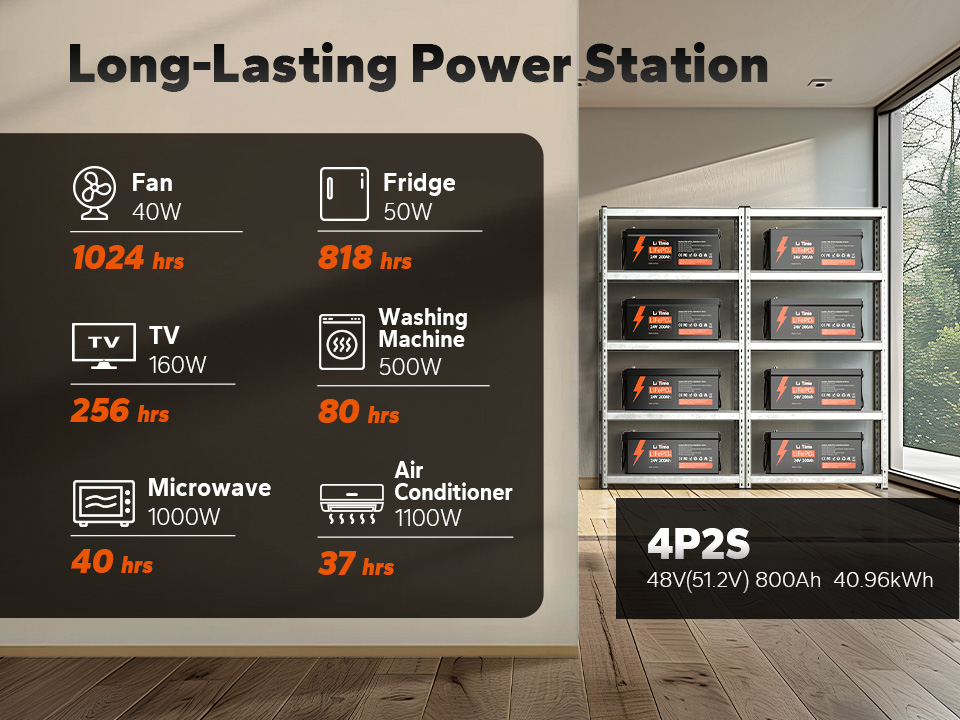
Assuming a full 100% Depth of Discharge (DOD) and a 90% inverter efficiency, let’s see how it performs in powering a typical household.
Background Data
According to energy consumption data from the Australian government (source: Australian Energy Statistics), the total national energy consumption for the fiscal year 2022-2023 was 274,474.841GWh.
With Australia's population at 26.64 million in 2023, the average daily energy consumption per person is about:
274,474.841GWh ÷ 26.64 million ÷ 365 days ≈ 28.227kWh/day.
This provides a solid reference for calculating the daily electricity needs of an average household.
How Long Will the Battery Last?
Assuming the battery is fully discharged (100% DOD) and the inverter works at 90% efficiency, the usable energy would be:
40.95kWh × 90% = 36.855kWh.
To calculate how long the battery will support household use:
36.855kWh ÷ 28.227kWh/day ≈ 1.45 days.
Result Interpretation
This means that the LiTime 25.6V 200Ah battery can, under ideal conditions, provide power for a typical Australian household for approximately 1.45 days for one person.
By using this formula, you can better understand the practical runtime of your battery based on your energy needs.
Example 2: LiTime 12V 200Ah LiFePO4 Lithium Battery in Different Use Cases
In this example, we'll explore how the LiTime 12V (12.8V) 200Ah LiFePO4 lithium battery performs when running different devices, assuming 100% Depth of Discharge (DOD) and 90% inverter efficiency.
I. Running a Trolling Motor with 50-60 lbs Thrust (Approx. 500W)
Formula Calculation
Total usable energy:
12.8V × 200Ah × 100% × 90% = 2,304Wh (2.304kWh).
Device runtime:
2,304Wh ÷ 500W ≈ 4.61 hours.
Result Interpretation
Under these conditions, a LiTime 12.8V 200Ah battery can power a 500W trolling motor for approximately 4.61 hours.
II. Running a Camping Portable Electric Stove (Approx. 1000W)
Formula Calculation
Total usable energy of the battery remains: 2,304Wh (2.304kWh).
Device runtime:
2,304Wh ÷ 1,000W ≈ 2.3 hours.
Result Interpretation
This same battery can run a 1000W portable stove for about 2.3 hours—ideal for short cooking sessions while camping.

III. Running a Household Table Lamp (Approx. 50W)
Formula Calculation
Total usable energy of the battery: 2,304Wh (2.304kWh).
Device runtime:
2,304Wh ÷ 50W ≈ 46.08 hours.
These examples clearly show how the power demand of different devices dramatically affects battery runtime.
- High-power deviceslike the trolling motor and electric stove drain the battery much faster.
- Low-power devicessuch as the table lamp, however, allow for much longer usage.
To maximize the runtime of your 200Ah battery, it’s important to optimize usage and choose the right devices based on your needs.
How to Maximize the Runtime of Your 200Ah Battery: Practical Tips
To get the most out of your 200Ah battery, here are some effective strategies for optimizing battery usage and extending your device's runtime:
1. Optimize Power Usage
- Choose Energy-Efficient Devices: Opt for devices that consume less power but are more efficient.
- Power Down Idle Devices: Reduce unnecessary power draw by turning off devices that aren't being used.
2. Boost Inverter Efficiency
- Use a high-efficiency inverter (≥90%) to reduce energy losses during the conversion from DC to AC.
- Regularly maintain your inverter to keep it operating at its best.
3. Manage Depth of Discharge
- Avoid Deep Discharge: While LiFePO4 batteries support 100% DOD, leaving a little reserve helps prolong battery life.
- Use in Intervals: When there’s a high power demand, use the battery in intervals to avoid putting too much strain on it in one go.
4. Maintain the Right Temperature
- Batteries perform optimally between 0°C and 40°C.
- Steer clear of using your battery in extreme temperatures (either too cold or too hot) to maintain steady performance.
5. Perform Regular Battery Maintenance
- Monitor Battery Health: Regularly check the condition of your battery to identify any potential issues early.
- Clean Battery Contacts: Keep the battery terminals and connections clean to prevent energy losses.
6. Charge with Solar or Other Devices
- Pair your battery with solar panels or other charging devices to recharge the battery while it's in use, extending the runtime.
- Ensure the charging equipment is compatible with the battery's voltage and current to avoid overcharging or overloading.
By following these simple steps, you can maximize the efficiency of your 200Ah battery and enjoy longer, more reliable power!
FAQ: Everything You Need to Know About the 200Ah Battery
1. How long does a 200Ah battery last when paired with an inverter?
Answer: The runtime is calculated using this formula:
Runtime = (Battery Capacity × Battery Voltage × Depth of Discharge × Inverter Efficiency) / Device Power
For example, with a 12.8V 200Ah battery, 90% inverter efficiency, and 100% Depth of Discharge:
- Running a 500W device: (200 × 12.8 × 1 × 0.9) / 500 = 4.61 hours.
- Running a 1000W device: You'll get about 2.3 hours of runtime. You can use this formula to quickly calculate runtime based on the device's power consumption.
2. Is a 200Ah battery suitable for a solar power system?
Answer: Absolutely, especially if you’re using Lithium Iron Phosphate (LiFePO4) batteries.
- These batteries support 100% Depth of Discharge, which means you can fully utilize the stored energy.
- They have a long cycle life, often lasting between 2000 to 5000 cycles, making them perfect for long-term storage.
- When paired with the right solar controller and inverter, these batteries help achieve efficient energy management in a solar setup.
3. How long will a 200Ah battery last in a solar system?
Answer: It depends on the design of the solar system and the load:
- For small loads like a 50W LED light, the battery would last: (200 × 12.8 × 1 × 0.9) / 50 ≈ 46 hours.
- For typical household consumption (e.g., 10kWh/day), you would need over 5 batteries of 200Ah (12.8V) in series and parallel to meet your energy needs.
4. Can a 200Ah battery be used and charged simultaneously?
Answer: Yes, but keep the following in mind:
- Make sure the combined power of the charger and load doesn't exceed the solar controller or inverter's maximum supported capacity.
- Use a Battery Management System (BMS) that supports simultaneous charging and discharging to keep your battery safe.
5. How long does it take to fully charge a 200Ah battery?
Answer: The charging time depends on the charger’s power:
- With a 40A charger, it will take about: 200Ah ÷ 40A ≈ 5 hours (theoretical, without accounting for efficiency losses).
- Using a more powerful charger will reduce charging time, but make sure not to exceed the battery’s maximum charging current.
6. How can I tell when it’s time to replace the battery?
Answer: Here are some signs that your battery may need replacing:
- If its capacity significantly drops and it doesn’t hold charge as long as it used to.
- If it overheats during charging or discharging.
- If it has reached the end of its cycle life, as recommended by the manufacturer.
